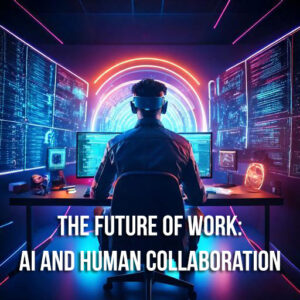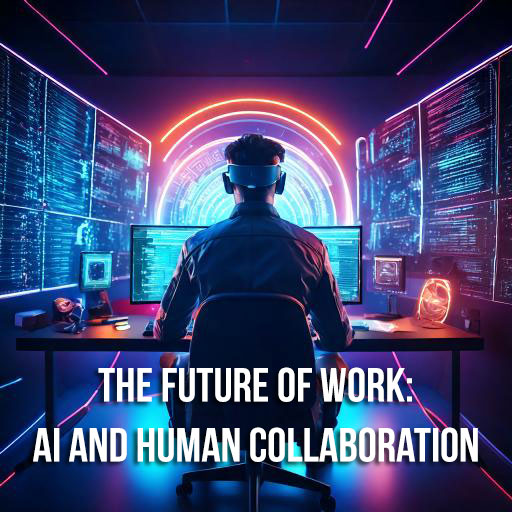 The Future of Work: AI and Human Collaboration
The Future of Work: AI and Human Collaboration
As AI (Artificial Intelligence) and AIDA (AI-Driven Automation) becomes increasingly integrated into our workplaces, a new paradigm is emerging – one that focuses on collaboration between humans and AIDA rather than replacement. This partnership is transforming how we work and creating new opportunities across industries.
Transforming Work
Traditional roles are evolving rather than disappearing. AIDA is great at processing vast amounts of data, identifying patterns, and performing repetitive tasks consistently. Humans, on the other hand, possess emotional intelligence, creative problem-solving, and nuanced judgement that AI has yet to replicate.
Tasks that once consumed significant human time and effort are being automated, allowing workers to focus on higher-value activities that require uniquely human capabilities. For instance, accountants are spending less time on manual data entry and more time providing strategic financial advice. Customer service representatives are handling fewer routine inquiries and focusing more on complex problem-solving and building customer relationships.
This evolution requires a new approach to skill development. Looking to the future, the workforce needs to be both tech-savvy and deeply human. Critical thinking, emotional intelligence, and adaptability are becoming as important as technical proficiency. The ability to effectively collaborate with AI tools is emerging as a crucial skill in itself. For example, prompt engineering is the skill of creating an instruction (or set of instructions) that can be interpreted by a generative AI algorithm. In other words, to get the best answer, you must know how to phrase the question.
Challenges and Considerations
The transition to AI-human collaboration isn’t without its challenges. Here are a few important factors organizations must carefully consider:
The need for transparent and explainable AI systems
Transparent and explainable AI is essential because it allows users, developers, and stakeholders to understand how AI systems make decisions, helping identify and correct biases or errors that could lead to harmful outcomes. Explainable AI also builds trust and accountability, making it easier for organizations to comply with regulations and to ensure AI systems serve the interests of an organization (and its ecosystem) rather than undermining them.
Maintaining human control and judgment in decision-making
While AI can enhance decision-making processes, maintaining human control and judgment is crucial because humans possess contextual understanding, emotional intelligence, and ethical reasoning capabilities that AI systems currently cannot replicate. Preserving human oversight ensures that AI remains a tool that augments rather than replaces human decision-making, particularly in complex situations involving ethical considerations, nuanced interpersonal factors, or regarding sensitive information.
Protecting privacy and security in AIDA applications
Protecting privacy and security in AIDA applications is critical because these systems often process sensitive personal, financial, or business data that, if compromised, could lead to significant harm through identity theft, financial fraud, or corporate espionage. Strong privacy and security measures help organizations maintain regulatory compliance, protect their reputation, and build trust with customers and stakeholders who need assurance that their data is being handled responsibly. Additionally, robust security protocols protect the AI systems themselves from manipulation or attacks that could compromise their functionality or lead to biased or harmful outputs.
The Road Ahead
The future workplace will likely be characterized by a balanced interaction between human workers and AIDA systems. We’re already seeing the emergence of “hybrid intelligence” workflows, where AIDA handles routine tasks and provides data-driven insights, while humans focus on strategy, creativity, oversight, and relationship-building.
This evolution requires thoughtful leadership and careful change management. Organizations need to:
- Invest in both technical infrastructure and human capital
- Develop clear protocols for human oversight and intervention
- Foster a culture of continuous learning and adaptation
- Ensure that AI implementations enhance rather than diminish human potential
Pantheon’s Odyssey AIDA can foster AI and human collaboration by providing a platform that seamlessly integrates AI capabilities with human workflows. With its AI-powered automation and integration capabilities, Odyssey AIDA can enhance human productivity and decision-making by automating repetitive tasks, analyzing data, and providing actionable insights.
Conclusion
The future of work isn’t about AI replacing humans—it’s about creating partnerships that enhance our capabilities. By thoughtfully combining the strengths of both, we can build workplaces that are more productive, creative, and fulfilling than ever before. The organizations that thrive will be those that embrace this collaboration while developing their uniquely human capabilities.
Contact us for additional information.


